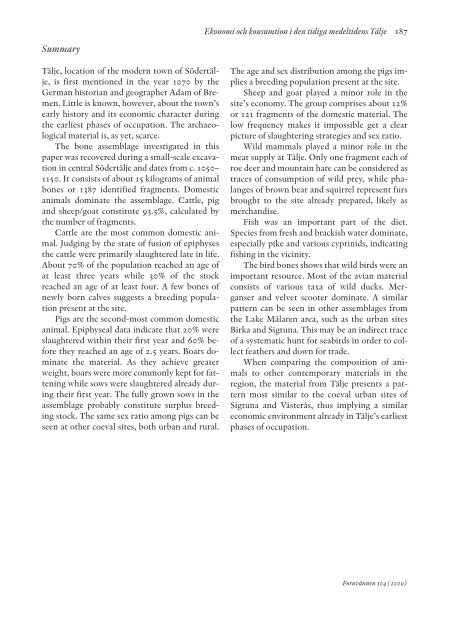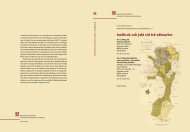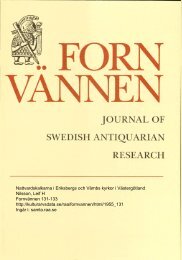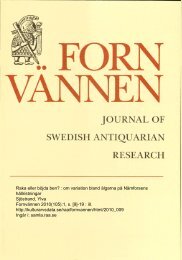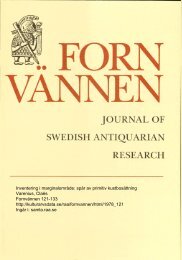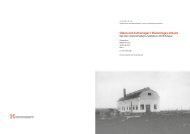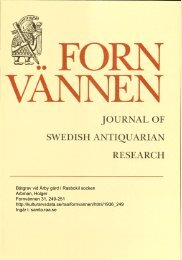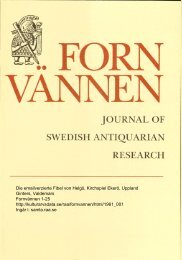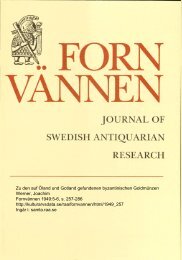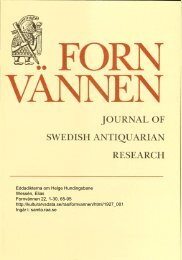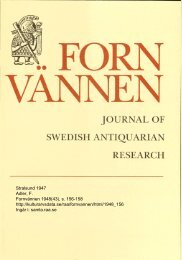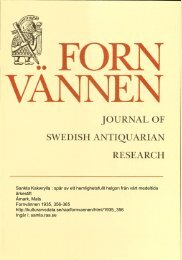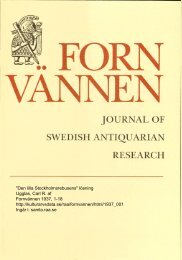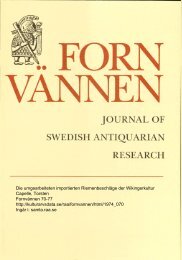Ekonomi och konsumtion i den tidiga medeltidens Tälje : en ...
Ekonomi och konsumtion i den tidiga medeltidens Tälje : en ...
Ekonomi och konsumtion i den tidiga medeltidens Tälje : en ...
You also want an ePaper? Increase the reach of your titles
YUMPU automatically turns print PDFs into web optimized ePapers that Google loves.
Summary<strong>Ekonomi</strong> <strong>och</strong> <strong>konsumtion</strong> i <strong>d<strong>en</strong></strong> <strong>tidiga</strong> medelti<strong>d<strong>en</strong></strong>s <strong>Tälje</strong>187<strong>Tälje</strong>, location of the modern town of Södertälje,is first m<strong>en</strong>tioned in the year 1070 by theGerman historian and geographer Adam of Brem<strong>en</strong>.Little is known, however, about the town’searly history and its economic character duringthe earliest phases of occupation. The archaeologicalmaterial is, as yet, scarce.The bone assemblage investigated in thispaper was recovered during a small-scale excavationin c<strong>en</strong>tral Södertälje and dates from c. 1050–1150. It consists of about 15 kilograms of animalbones or 1387 i<strong>d<strong>en</strong></strong>tified fragm<strong>en</strong>ts. Domesticanimals dominate the assemblage. Cattle, pigand sheep/goat constitute 93.5%, calculated bythe number of fragm<strong>en</strong>ts.Cattle are the most common domestic animal.Judging by the state of fusion of epiphysesthe cattle were primarily slaughtered late in life.About 70% of the population reached an age ofat least three years while 30% of the stockreached an age of at least four. A few bones ofnewly born calves suggests a breeding populationpres<strong>en</strong>t at the site.Pigs are the second-most common domesticanimal. Epiphyseal data indicate that 20% wereslaughtered within their first year and 60% be -fore they reached an age of 2.5 years. Boars do -minate the material. As they achieve greaterweight, boars were more commonly kept for fatt<strong>en</strong>ingwhile sows were slaughtered already duringtheir first year. The fully grown sows in theassemblage probably constitute surplus breedingstock. The same sex ratio among pigs can bese<strong>en</strong> at other coeval sites, both urban and rural.The age and sex distribution among the pigs im -plies a breeding population pres<strong>en</strong>t at the site.Sheep and goat played a minor role in thesite’s economy. The group comprises about 12%or 121 fragm<strong>en</strong>ts of the domestic material. Thelow frequ<strong>en</strong>cy makes it impossible get a clearpicture of slaughtering strategies and sex ratio.Wild mammals played a minor role in themeat supply at <strong>Tälje</strong>. Only one fragm<strong>en</strong>t each ofroe deer and mountain hare can be considered astraces of consumption of wild prey, while phalangesof brown bear and squirrel repres<strong>en</strong>t fursbrought to the site already prepared, likely asmerchandise.Fish was an important part of the diet.Species from fresh and brackish water dominate,especially pike and various cyprinids, indicatingfishing in the vicinity.The bird bones shows that wild birds were animportant resource. Most of the avian materialconsists of various taxa of wild ducks. Merganserand velvet scooter dominate. A similarpattern can be se<strong>en</strong> in other assemblages fromthe Lake Mälar<strong>en</strong> area, such as the urban sitesBirka and Sigtuna. This may be an indirect traceof a systematic hunt for seabirds in order to collectfeathers and down for trade.Wh<strong>en</strong> comparing the composition of animalsto other contemporary materials in theregion, the material from <strong>Tälje</strong> pres<strong>en</strong>ts a patternmost similar to the coeval urban sites ofSigtuna and Västerås, thus implying a similareconomic <strong>en</strong>vironm<strong>en</strong>t already in <strong>Tälje</strong>’s earliestphases of occupation.Fornvänn<strong>en</strong> 104 (2009)


